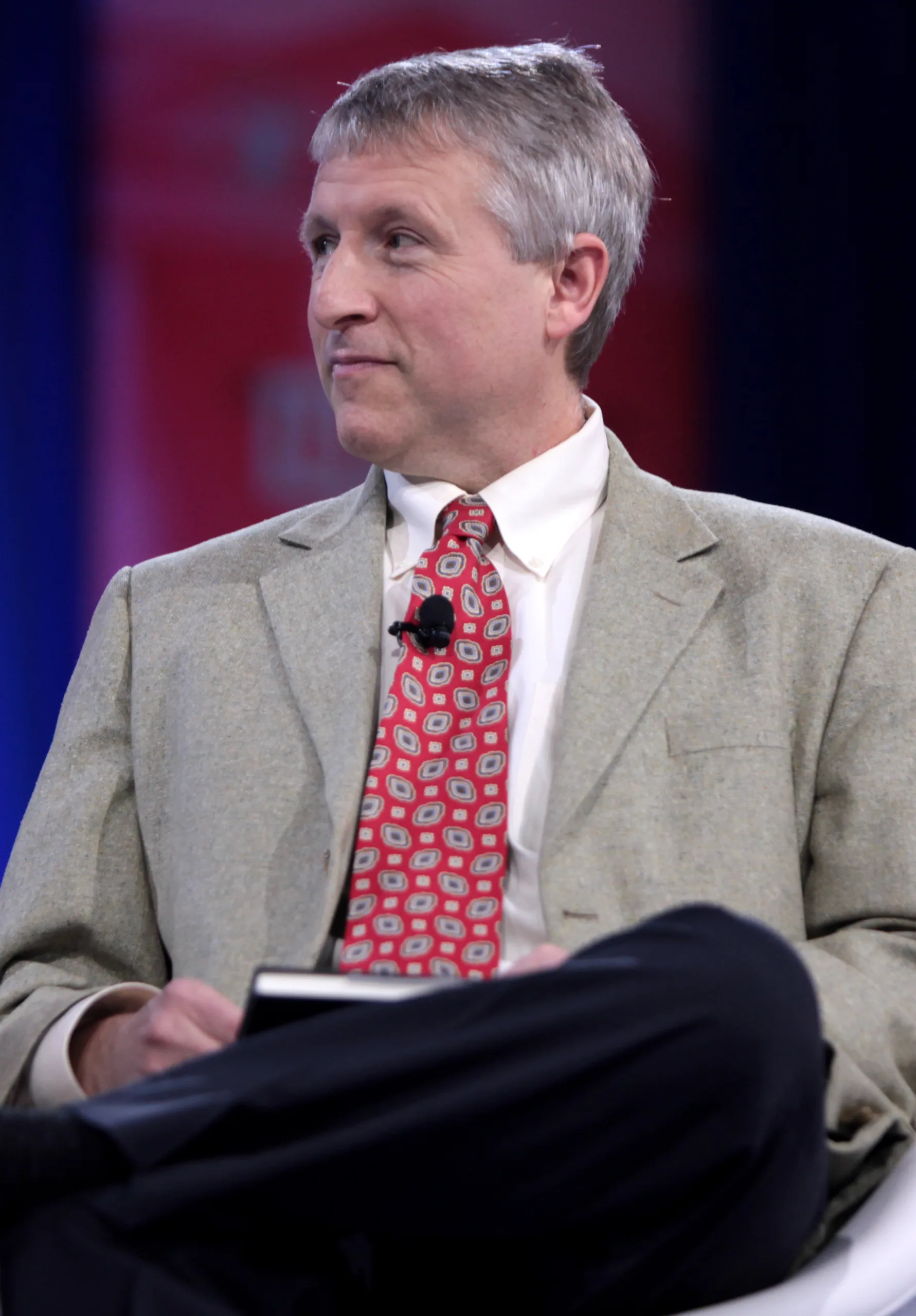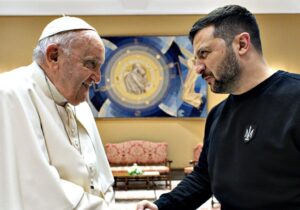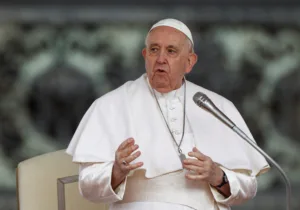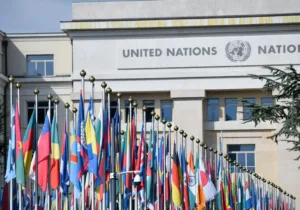This article about Pope John Paul II, Ronald Reagan, and communism’s collapse first appeared in the Spring 2017 issue of Providence’s print edition. To read the original in a PDF format, click here. To receive full copies of future issues once they are printed, subscribe for only $28 a year!
On March 30, 1981, just outside the Washington Hilton in the heart of the nation’s capital, Ronald Reagan, the 40th president of the United States and leader of the free world, was shot by a would-be assassin.
On May 13, 1981, just outside the Vatican in the heart of St. Peter’s Square, Pope John Paul II, 264th occupant of the chair of St. Peter and leader of the world’s largest group of Christians, was shot by a would-be assassin.
These shocking moments rocked international headlines. And we now know today what an anxious world did not know then: both men came perilously close to dying. Had they not survived, the 20th century would not have ended as it did, surely not as joyously as it did—that is, with the Cold War ending as it did. Soviet communism would not have been dispatched to what Reagan called “the ash-heap of history”—or certainly not as soon or peacefully.
For Americans, for Europeans, for Protestants and Catholics, for Jews, for believers of all stripes, and for so many others worldwide, the momentous and tranquil termination of the Cold War was the signature event of the close of the 20th century. It was one of the most remarkable events of the entire turbulent century, a century where over 100 million people were killed by communist governments, far exceeding the combined death tolls of World War I and World War II, history’s deadliest wars. And Ronald Reagan and John Paul II teamed up to seek precisely that historic victory, an outcome they perceived as not only historical but spiritual. For both men, the Soviet empire was not a mere empire, but an atheistic empire that pursued what Mikhail Gorbachev described as a “war on religion.” It was, as Reagan put it, an “Evil Empire.”
What did Pope John Paul II mean to America in that battle against atheistic communism? What did he mean to America’s president in that epic fight against evil? And what did President Reagan mean to the Polish pontiff, the Vatican, and the Roman Catholic Church’s two-century-long assault on communism?[i] How did these two men see the hand of Providence in what they did?
The following offers a look at what these two extremely influential statesmen did in pursuing Cold War victory. These pages are a tiny portion of what I detail at great length in a book published this May 2017. This article cannot give due justice to the Reagan-John Paul II extraordinary joint effort. Nonetheless, it does attempt to offer a glimpse.
Transcending Communism
The American public got a taste of John Paul’s significance to Ronald Reagan when the nation’s new president, still recovering from the shooting on March 30, stepped to the podium to speak at Notre Dame University—America’s premier Catholic college—on May 17, 1981, only days after the pontiff had been shot in St. Peter’s Square.
It was Reagan’s first public speech since the shooting of the pope, and it happened to be at a college named after the Virgin Mary, to whom John Paul II had a special dedication.
Reagan had earlier accepted the invitation to be the commencement speaker, and he had too much to say to pass up the invite, even amid his ongoing recovery. Reagan began his remarks by acknowledging not his own health situation but that of the pope—wishing him well for a speedy recovery, and drawing grateful applause. It is very interesting what followed next.
Next came a stirring statement in the president’s text. It went hand-in-glove with his thoughts about the pope, whom Reagan was already viewing as a partner against Soviet communism: “The years ahead are great ones for this country, for the cause of freedom and the spread of civilization,” said Reagan. “The West won’t contain communism, it will transcend communism… It will dismiss it as some bizarre chapter in human history whose last pages are even now being written.”
People were amazed at what Reagan asserted. Many outright laughed.
That audacious prediction, particularly alongside his remarks on the pope, was actually a statement that foreshadowed Reagan’s policy and his intentions with John Paul II: he would not seek to contain communism; he would seek to reverse and defeat communism.
The 40th president spoke to his audience about a higher cause and challenge. He rallied them to a “common cause” that was “bigger than ourselves,” to “attain the unattainable.” If Americans met this challenge, history would look back, Reagan assured, and determine that “the American Nation came of age,” that it “affirmed its leadership of free men and women serving selflessly a vision of man with God.” He invoked: “It is time for the world to know our intellectual and spiritual values are rooted in the source of all strength, a belief in a Supreme Being, and a law higher than our own.”
Reagan drew on remarks made by Winston Churchill during the ominous Battle of Britain: “When great causes are on the move in the world, we learn we are spirits, not animals, and that something is going on in space and time, and beyond space and time, which, whether we like it or not, spells duty.” To Reagan, the obligation Americans must meet was their duty to fight expansionist Soviet Marxism. This was a higher duty separating humans from beasts. It was a transcendent cause that would be implicit to transcending atheistic communism.
In that, Ronald Reagan saw Pope John Paul II as his partner in a battle as spiritual as political. And he also saw the Slavic pope’s native land, Poland, as a pivotal spot where the battle could be waged and won.
Poland: The First “Cracks” in the Communist Bloc
One month after that Notre Dame speech, a reporter during a White House press conference dared Reagan to stand by his bold prediction. Reagan went further, telling the press that he believed that recent intrigues in Poland, in particular, were an added sign of communism’s doom. “Communism is an aberration,” insisted Reagan. “It’s not a moral way of living for human beings, and I think we are seeing the first, beginning cracks, the beginning of the end.”[ii]
The cracks intensified on December 13, 1981. The Polish communist government, acting under orders from Moscow, declared martial law on the Polish people, with the Solidarity movement the main focus of the crackdown. Solidarity was a fiercely independent, anti-communist, anti-Soviet labor union led by Lech Walesa, an electrician from the Lenin Shipyard (ironically) in Gdansk. Practically every worker in Poland was a member, an unacceptable situation for the communists.
Solidarity leaders were rounded up and arrested and silenced. There was armed violence by the communist police and military. The communists were shooting the workers. The Party was smashing the Proletariat.
The Soviet leadership issued a statement of support for martial law. For its part, Solidarity, under siege, issued an appeal to friends everywhere: “We appeal to you: help us in our struggle by mass protests and moral support. Do not watch passively the attempts to strangle the beginnings of democracy in the heart of Europe. Be with us in these difficult moments. Solidarity with Solidarity. Poland is not yet lost.”[iii]
Among the friends who listened to these words intently were the Polish pope and the American president. Both committed to save and sustain Solidarity as the wedge that—they believed, they judged—could ultimately splinter the Soviet bloc from top to bottom. To Ronald Reagan, the ugliness that was martial law presented beautiful possibilities—and Pope John Paul II, in Reagan’s mind, could join him in exploiting and pursuing those possibilities.
The Pope’s Visit to Poland
Before considering those next steps, let’s take a step back.
It is critical to understand that, long before the explosive events of December 1981, Ronald Reagan had believed that Poland could be the catalyst to knock down the Soviet dominoes in Eastern Europe.
Ronald Reagan viewed Poles as tragic victims of two totalitarianisms: Nazism and Bolshevism. He spoke of “the martyred nation of Poland.” The Allies had liberated Poland in World War II but sold it down the river to Stalin at Yalta. Reagan hated Yalta, calling it “immoral.” He hoped to someday “undo” the damage.
Thus, Reagan was especially affected by two huge events in the two years prior to his election in November 1980: the Vatican in October 1978 chose its first non-Italian pope in 455 years and its first Slavic pope ever, one from Poland no less, the heart of the Soviet bloc; and the new pope took a nine-day pilgrimage to his Polish homeland in June 1979. The new man in Rome shrewdly chose Poland as his first foreign visit. Moscow was scared to death.
Reagan paid close attention to the pope’s June 1979 trip, where the Holy Father—as the secret police pressed in—stoically told his brothers and sisters, in words packed with New Testament meaning, to “Be not afraid.” John Paul II openly insisted that all Eastern European governments be allowed freedom of conscience, individual rights, private property, elections, and independence. He asserted: “There can be no just Europe without the independence of Poland marked on its map!”
That was a riveting statement that bears repeating: “there can be no just Europe without the independence of Poland marked on its map!”
That was a shot heard in Moscow. It was also heard by Ronald Reagan.
Reagan was elated. He spoke out excitedly about what he saw from afar. He had a popular daily radio commentary heard on thousands of stations across the country. He paused to record several broadcasts on the pope’s trip. In these, Reagan blasted the “communist atheism” that had preyed on Poland following World War II. It outraged Reagan that, “These young people of Poland had been born and raised and spent their entire lives under communist atheism.” He asked: “Once in the days of Stalin he is said to have dismissed the Vatican by contemptuously asking: ‘How many divisions does the pope have?’ Well, in recent weeks that question has been answered by Pope John Paul II. It has been a long time since we’ve seen a leader of such courage and such uncompromising dedication to simple morality—to the belief that right does make might.”[iv]
Reagan noted that wherever the pontiff traveled in Poland, he was greeted by “unbelievable numbers” of people. The future Great Communicator told his fellow Americans that for 40 years the Polish people had lived first under the Nazis and then the Soviets. The voices behind those tanks and guns told them there is no God. Now, said Reagan, Pope John Paul II had come to remind his fellow Poles and the world that there is a God and they had a right to freely worship that God. Reagan asked: “Will the Kremlin ever be the same again? Will any of us for that matter?”
Reagan was never the same again. He recognized that this was a momentous event that threatened communism’s hold on Eastern Europe. As he watched news footage of the pope’s visit from his California home, where he sat next to his friend and adviser Richard V. Allen, Reagan was visibly moved to tears. He told Allen (as he would tell others) that John Paul II was “the key” to help Poland become the splinter to break up the Soviet empire.[v]
For the record, the future president’s powerful thinking on the potential of Poland and the pope’s 1979 visit was not the shared opinion of the West. In an editorial on June 5, 1979, The New York Times declared authoritatively: “As much as the visit of Pope John Paul II to Poland must reinvigorate and re-inspire the Roman Catholic Church in Poland, it does not threaten the political order of the nation or of Eastern Europe.”[vi]
The Times could not have been more wrong. Fortunately for Poland, for Eastern Europe, for America, for the world, and for the cause of freedom, the views of The New York Times were never those of Ronald Reagan or John Paul II.
Reagan further resolved to get himself elected president and one day reach out to the Pope and Vatican to “make them an ally.”
“Dubious Distinction”
Reagan’s chances of getting to that point took a major jump forward when he defeated Jimmy Carter in November 1980, winning 44 of 50 states and defeating the incumbent president in an Electoral College landslide, 489 to 49.
Reagan wasted no time reaching out to the Vatican, even going so far as to contact a pleasantly surprised Archbishop Pio Laghi and congratulating him for being named papal nuncio to Washington. Reagan did so from the headquarters of his transition team. Reagan was still weeks away from his inauguration; nonetheless, he yearned to get together with the Vatican, with the pope, as soon as he could.
Any such progress, however, came to a vicious halt amid a series of bullets that flew in Washington and Rome in March and May 1981. Ironically, these shots, which could have forever separated Reagan and John Paul II, drew them closer.
On May 18, only five days after the pope was shot, Reagan sent the pontiff a second personal note since the shooting—this one a birthday wish, but much more than that. The letter was delivered personally to the pontiff by Rep. Peter Rodino (D-NJ) on a Sunday evening. In that letter, Reagan shared his unique form of identification with the pope:
Happily, few leaders in the world today have the dubious distinction of knowing with some precision the kind of event you have just experienced. Fewer still can appreciate, as can I, the depth of courage and commitment on which you must have called, not only to survive that horrible event but to do so with such grace, nobility, and forgiveness.
Your heroism, and the universal outpouring of love and concern which it evoked, is proof that a single irrational act cannot prevail against the basic human decency which continues to inspire most people in most places. The qualities you exemplify remain a precious asset as we confront the growing dangers of the moment—confront them with confidence and faith.
Their historic paths began with sacrifice. It was as if they had to start their journey together against the Soviet monster by first carrying the cross—to be made worthy of the historical-spiritual mission ahead.
The Soviets had worried about an anti-communist, anti-Moscow kinship between the president and the pope; now they had better worry more so.
June 7, 1982: Meeting at the Vatican—& More
The pope and the president at long last came together on June 7, 1982, at the Vatican.
“It was always assumed the president would meet with the Holy Father as soon as feasible,” said Bill Clark, President Reagan’s closest aide, and a devout Catholic who admired John Paul II. “Because of their mutual interests, the two men would come together and form some sort of collaboration.”[vii]
The two talked alone for 50 minutes in the Vatican Library. The attempted assassinations were raised right away. Pio Laghi later recounted that Reagan told the pope: “Look how the evil forces were put in our way and how Providence intervened.” Clark confirmed that sentiment, saying that both referred to the “miraculous” fact that they had survived.[viii]
The Protestant and Catholic, said Clark, shared a “unity” in spiritual views and in their “vision on the Soviet empire,” namely, “that right or correctness would ultimately prevail in the divine plan.”
In fact, Clark and Reagan had their own pet phrase for this divine plan; the two old friends called it “The DP.”
That day in Rome, said Clark, they shared their common view that they had been given “a spiritual mission—a special role in the divine plan.” Both expressed concern for “the terrible oppression of atheistic communism,” as Clark put it, and agreed that “atheistic communism lived a lie that…must ultimately fail.”[ix]
They also had common visions on what should be done. As Reagan said, “We both felt that a great mistake had been made at Yalta and something should be done. Solidarity was the very weapon for bringing this about.” Reagan told the pope: “Hope remains in Poland. We, working together, can keep it alive.”[x]
June 7, 1982, was far from the only time the two men or their staffs would meet. Much more was in store; they would meet five more times in total. A substantial effort ensued, conducted in close coordination between the White House and Vatican. The major players included Clark, CIA Director Bill Casey, Ambassador Vernon Walters, Cardinal Pio Laghi, and Cardinal Agostino Casaroli.
Clark characterized the nature of the collaboration: “We knew we were both going in the same direction and so we decided to collaborate, particularly on intelligence issues regarding the Eastern Bloc.” Clark told me: “There was a natural convergence of interests, which led officials at the White House to work together with their counterparts at the Vatican.”
Clark dubbed the mutual effort a “successful collaboration” led “under Ronald Reagan’s direction.” He says that he, Casey, Ambassador Walters—all active Catholics—and Laghi “played extensive roles.”
Among the numerous exchanges, those between Clark, Casey, and Laghi are especially interesting. The June 1982 meeting at the Vatican led to something that Clark colorfully dubbed “Cappuccino Diplomacy.”[xi] Clark explained: “Casey and I dropped into his [Laghi’s] residence early mornings during critical times to gather his comments and counsel. We’d have breakfast and coffee and discuss what was being done in Poland. I’d speak to him frequently on the phone, and he would be in touch with the pope.”[xii]
Laghi’s coffee, Clark always told me with a smile, was the good stuff—genuine Italian cappuccino, which, in Washington in the 1980s, was not available on every block. The coffee became a code. Alert to the possibility that their phone lines might be bugged by Russian listening devices, Clark and Casey, when they felt they needed to once again touch base with the Vatican, would coyly say to one another, “Would you like to have some cappuccino?” This meant it was time to consult the papal nuncio.
Clark said that his contacts with Laghi occurred “at least weekly,” and sometimes more.
The conversations, said Clark, were always “back channel.” No note-takers, and absolutely no media. This was done completely outside normal channels, especially outside State Department channels.
Here were three Catholic men, two of them Irish and one Italian, who relished figuring out what the Soviets were up to, who discerned “the DP” for this remarkable time they were living through, and who seemed to nervously enjoy plotting the demise of the USSR.
Outside the United States, briefings were provided at the Vatican by Casey and Walters. Casey flew secret missions to Rome in a windowless C-141 black jet. The Reagan administration fueled an intelligence shuttle between Washington and the Holy See, through which Casey and Walters clandestinely briefed the pope on a regular basis. Between them, they paid at least 15 secret visits to John Paul II over a six-year period.[xiii]
Both the pope and the president eagerly anticipated the information gained from these varied briefings. And beyond the human intelligence shared, the pope benefited from the mighty arm of U.S. technical intelligence, receiving some of the nation’s most guarded secrets and sophisticated analysis. He was able to pour over satellite imagery detailed beyond his conception.
A “Best Friend” & a Collapse
The various personal contacts, letters, cables, diplomatic pouches, telephone calls, and more between Reagan and John Paul II and their liaisons are too many to note here. The White House documents today are mostly declassified, largely through FOIA requests I personally began submitting in 2000. The letters from the pope were typically embedded within White House Situation Room cables labeled “SECRET,” and are still today totally redacted. One batch I received from the Reagan Library in June 2009 included four letters the Vatican/pope sent in January 1982 alone—and all remained completely blacked out. As for Vatican documents, they are sealed for 75 years from date—no exceptions.
So many contacts, so much information. But with that said, it may be particularly revealing to look back to the day after that initial June 7, 1982, face-to-face meeting at the Vatican.
On June 8, President Reagan went to London. He had left the Vatican reinvigorated with a spiritual zeal to undermine communism. At Westminster, Reagan gave the most prescient speech of his presidency, proclaiming: “What I am describing now is a policy and a hope for the long term—the march of freedom and democracy which will leave Marxism-Leninism on the ash-heap of history.” Very tellingly, Reagan opted for the word “policy” in addition to “hope.”
And that, of course, is precisely what would happen: a policy to undermine Soviet communism, culminating in the historic events of 1989. That year is remembered for the fall of the Berlin Wall, the enduring symbol of the collapse. In truth, however, the first domino fell earlier that year, with elections in Poland. What happened in Poland with those elections, as Mikhail Gorbachev himself would put it, threatened not only “chaos in Poland” but the “ensuing break-up of the entire Socialist camp.” When those elections were held in Poland in June 1989, Gorbachev saw the writing on the wall.[xiv]
And those elections, too, carry another meaningful Reagan-John Paul II moment:
It was the spring of 1989. Ronald Reagan’s two terms as president were over. Poland, the nation he so long respected, was preparing for what in December 1981 would have been unimaginable: free and fair parliamentary elections, open to candidates from any political party, Solidarity included. History was on the verge of being made.
A few weeks before the elections, Reagan had a visit at his California office from two Solidarity members and two Polish Americans hosting them. One host, Chris Zawitkowski, head of the Polish-American Foundation for Economic Research and Education, asked Reagan, the master campaigner, if he had any words of political wisdom for the two Solidarity members as they prepared for the June elections. The men expected to hear about political strategy, but were taken aback by what they heard from the seasoned candidate: “Listen to your conscience,” said Reagan, “because that is where the Holy Spirit speaks to you.”[xv]
The ex-president then pointed to a picture of Pope John Paul II on his office wall: “He is my best friend,” said Reagan with a smile. “Yes, you know I’m Protestant, but he’s still my best friend.”
His “best friend”—so said Ronald Reagan himself. It was surely an exaggeration personally speaking, but it was just as surely spot-on as a poignant testimony to what the two friends achieved on the international stage.
By the end of the year, communism would collapse in Eastern Europe. Fittingly, the ultimate sign of communist death came on Christmas Day 1989 in Romania, when the people there somehow rose up and rid themselves of the worst dictator in the entire Communist Bloc: Nicolai Ceausescu.
Christmas Day, once banned in the communist world, would come to hold double significance, as the final blow to the crumbling Soviet empire arrived precisely two years later, on December 25, 1991. On that December day, Mikhail Gorbachev, jockeying for leadership with another president in Moscow—Boris Yeltsin, an anti-communist who had been freely elected as Russia’s president the previous June—announced to a shocked world that he was resigning his position as head of the USSR. In so doing, he effectively resigned the Soviet Union itself.
The Cold War was over, without a missile fired, without the nuclear Armageddon that everyone feared for so long. It was extraordinary: that entire totalitarian system, which destroyed so much and so many, went down peacefully. It was a testimony to the work of Ronald Reagan, John Paul II, and also to names like Gorbachev, Yeltsin, Walesa, Vaclav Havel, and Margaret Thatcher.
* * *
But among that cast of historic figures, there were two, a Catholic and a Protestant, a Pole and an American, at the Vatican and at the White House, who uniquely stood out and stood together; they together resolved to stop the atheistic Soviet empire. Both placed a dagger in the black heart of murderous, atheistic Soviet communism. Together, they helped end the USSR and the Cold War, and did so peacefully.
Many Americans credit Ronald Reagan for that historic triumph, and many also credit a man named Karol Wojtyla, Poland’s native son. Ronald Reagan surely could not have achieved what he did without Pope John Paul II, his best friend in that endeavor. And John Paul II, likewise, surely could not have done what he did without Ronald Reagan.
It was a historic and extraordinary partnership and victory—and surely the work of Providence and the “DP” fulfilled.
—
Paul Kengor is professor of political science at Grove City College and executive director of the college’s Center for Vision & Values. He is author of over a dozen books, including his newly released A Pope and a President: John Paul II, Ronald Reagan, and the Extraordinary Untold Story of the 20th Century.
Photo Credit: President Reagan addressing the American Seminarians and Priests with Nancy Reagan and Pope John Paul II on June 7, 1982, in the Clementine Hall, Vatican City, Italy. Source: Ronald Reagan Presidential Library.
[i] That assault dates back to Pope Pius IX’s condemnation of communism in the encyclical Qui pluribus (On Faith and Religion), released in November 1846, two years before the publication of the Communist Manifesto.
[ii] Reagan, “The President’s News Conference,” Public Papers of the Presidents: Ronald Reagan, June 16, 1981.
[iii] David Cross, “Shooting reported in Poland as troops break wave of strikes,” London Times, December 16, 1981.
[iv] Located in “Ronald Reagan: Pre-Presidential Papers: Selected Radio Broadcasts, 1975-1979,” October 31, 1978 to October 1979, Box 4, Ronald Reagan Library (RRL). For a full transcript, see Kiron Skinner, Martin Anderson, and Annelise Anderson, Reagan, In His Own Hand (New York: Free Press, 2001), pp. 176-77.
[v] Source: Multiple author interviews and discussions with Richard V. Allen.
[vi] Editorial, “The Polish Pope in Poland,” The New York Times, June 5, 1979.
[vii] Interview with Bill Clark, August 24, 2001. This was the first of many such conversations I had with Clark on this subject.
[viii] See Carl Bernstein, “The Holy Alliance,” Time, February 24, 1992, pp. 28 and 30.
[ix] See “The Pope and the President: A key adviser reflects on the Reagan Administration,” interview with Bill Clark, Catholic World Report, November 1999; and Bernstein, “The Holy Alliance,” p. 30.
[x] Quoted in Peter Schweizer, Reagan’s War (New York: Doubleday, 2002), p. 213.
[xi] Paul Kengor and Patricia Clark Doerner, The Judge: William P. Clark, Ronald Reagan’s Top-Hand (San Francisco: Ignatius Press, 2007).
[xii] See Bernstein, “The Holy Alliance.”
[xiii] Ibid.
[xiv] Mikhail Gorbachev, Memoirs (New York: Doubleday, 1996), pp. 478-9.
[xv] This information was shared with me by Zawitkowski. Interview with Chris M. Zawitkowski, November 9, 2005.







 Sponsor a student for Christianity & National Security 2024
Sponsor a student for Christianity & National Security 2024